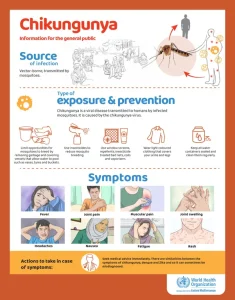18 Nov 2023 Chikungunya
This article covers “Daily Current Affairs” and the topic details “ Chikungunya”. This topic has relevance in the Science and Technology section of the UPSC CSE exam.
For Prelims:
About Chikungunya?
About the Chikungunya Vaccine?
For Mains:
GS 3: Science and Technology
Factors Contributing to the Rise in Chikungunya Cases?
Governmental Measures to Combat Chikungunya?
Why in the news?
The United States FDA has granted approval to the world’s first vaccine for Chikungunya.
About Chikungunya
- Chikungunya is a viral infectious disease primarily transmitted to humans through mosquito bites.
- Causative Agent: Caused by the Chikungunya virus (CHIKV), an RNA virus belonging to the alphavirus genus in the family Togaviridae.
- Historical Context: First reported in Tanzania in 1952, Chikungunya later spread to various regions across Asia, Africa, and the Americas.
- Transmission: Transmitted by Aedes aegypti and Aedes albopictus mosquitoes, which are also vectors for dengue and Zika viruses. These mosquitoes are active during the daytime. Additionally, transmission from a pregnant woman to newborns is possible.
- Symptoms: Symptoms include severe joint pain, reduced mobility, fever, joint swelling, muscle pain, headache, nausea, fatigue, and rash. Similar symptoms with dengue and Zika viruses can lead to misdiagnosis.
- Treatment: Clinical management involves anti-pyretics, optimal analgesics, fluid intake, and rest. There is no specific antiviral drug for CHIKV infections.
- Prevention & Control: Focus on controlling mosquito vectors, avoiding bites, and using preventive measures like mosquito nets, repellents, and insecticides.

Chikungunya Vaccine:
- Ixchiq is a single-dose vaccine containing a live, weakened Chikungunya virus, potentially causing symptoms akin to natural infection.
- Developed by Valneva, a European vaccine manufacturing company. It is approved for individuals aged 18 years or older, who are at an increased risk of virus exposure.
Factors Contributing to the Rise in Chikungunya Cases:
The surge in Chikungunya cases can be attributed to several factors, particularly in urban, peri-urban, and rural areas:
- Haphazard Urbanization: Unplanned and rapid urbanization has created conducive environments for the proliferation of disease vectors.
- Inadequate Water and Waste Management: Deficient management of water resources and solid waste has resulted in the creation of breeding sites for mosquitoes, facilitating the spread of Chikungunya.
- Lack of Antiviral Drug or Vaccine: The absence of a specific antiviral drug or vaccine leaves the population vulnerable to Chikungunya, as there is no targeted medical intervention available.
Governmental Measures to Combat Chikungunya:
The Indian government has implemented initiatives to prevent and control Chikungunya, primarily through the National Vector Borne Disease Control Programme (NVBDCP):
- A comprehensive program under the Ministry of Health and Family Welfare.
- Focuses on preventing and controlling various vector-borne diseases, including Chikungunya.
- Aims to create awareness, conduct surveillance, and implement measures to reduce the incidence of diseases like Malaria, Filaria, Kala-azar, Japanese Encephalitis (JE), Dengue, and Chikungunya.
Source: How was the first vaccine for chikungunya approved? | Explained – The Hindu
Download Yojna daily current affairs eng med 18th November 2023
Q.1 Regarding the Chikungunya recently seen in the news, consider the following statements:
- The Chikungunya virus is a DNA virus belonging to the alphavirus genus.
- Chikungunya is primarily transmitted by Anopheles mosquitoes.
- Transmission from a pregnant woman to newborns is not possible.
How many of the above statements are correct?
(a) Only one
(b) Only two
(c) All three
(d) None
ANSWER: D
Q.2 Regarding the Chikungunya Vaccine recently seen in the news, consider the following statements:
- Ixchiq is a multi-dose vaccine containing a live, weakened Chikungunya virus.
- The Chikungunya vaccine is approved for individuals of any age who are at risk of virus exposure.
Which of the statements given above is/are correct?
(a) 1 only
(b) 2 only
(c) Both 1 and 2
(d) Neither 1 nor 2
ANSWER: D
Q.3 Examine the impact of vector-borne diseases on public health in developing countries.


No Comments